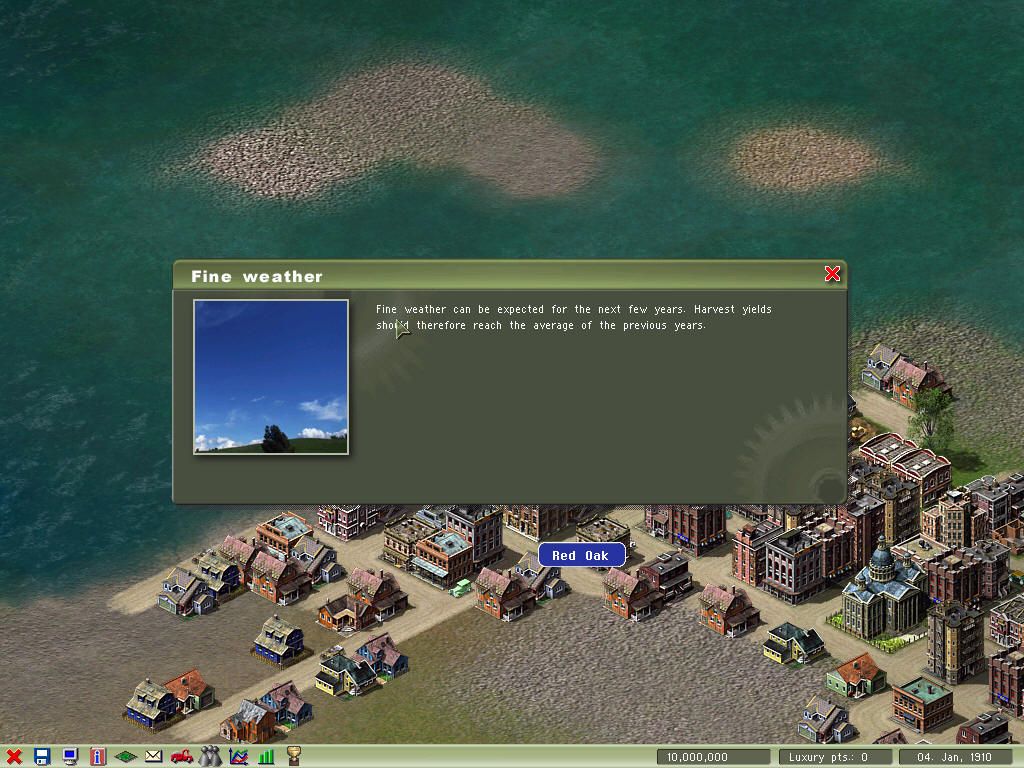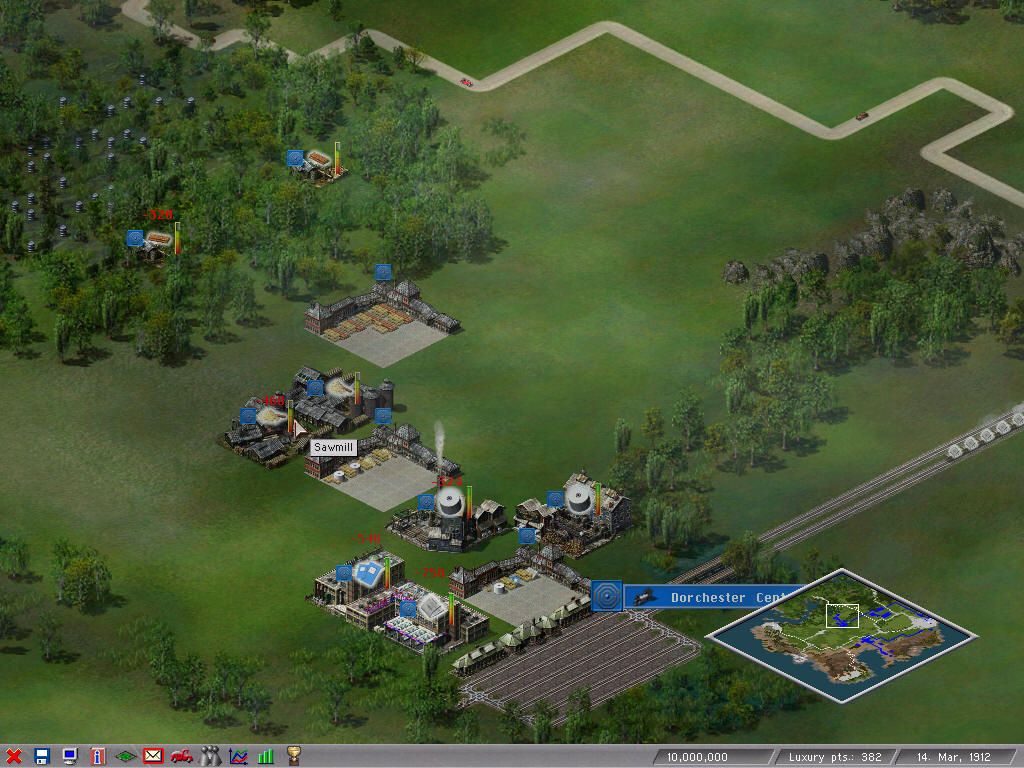Retro Replay Review
Gameplay
Industry Giant II drops you into the shoes of a 20th-century industrial magnate, tasking you with orchestrating everything from raw material extraction to retail distribution. You begin by choosing agricultural or mining sites—fields of cotton, sheep pastures for wool, or silica quarries for glassmaking. These inputs feed into a sprawling production chain of over 150 raw materials and finished goods. Cotton, for example, can be spun into cloth in textile mills before being sewn into garments at a clothing factory, while silica becomes glass at a glassworks, later turning into lucrative glass bottles or panes.
(HEY YOU!! We hope you enjoy! We try not to run ads. So basically, this is a very expensive hobby running this site. Please consider joining us for updates, forums, and more. Network w/ us to make some cash or friends while retro gaming, and you can win some free retro games for posting. Okay, carry on 👍)
Seasonal demand adds a nuanced layer of strategy. Your cotton clothes fly off the shelves in summer, only to see demand tank once winter sets in—when woolen garments take center stage. Balancing these cycles means you must anticipate consumer needs and adjust manufacturing schedules accordingly. Meanwhile, transportation networks—comprising 50 different options, from trucks and trains to ships—become vital arteries that connect factories, warehouses, and retail outlets. Each mode has its own speed, capacity, and cost profile, pushing you to optimize your logistics for maximum profit.
Two core modes shape your play experience: Scenario and Free Play. Scenarios present specific objectives—hit a revenue target, stockpile a certain product, or achieve a set company valuation within a time limit. These bite-sized challenges force you to think on your feet, often tweaking your entire supply chain to meet tight goals. Free Play, on the other hand, removes the clock, offering an open sandbox that spans decades. Here, you steadily expand into new industries—furniture, electronics, even luxury sports goods—and nurture burgeoning cities whose growth depends on a steady flow of manufactured products and civic investments like universities and stadiums.
Graphics
Industry Giant II employs an isometric 2D graphical style that, while modest by modern standards, still clearly conveys the sprawling complexity of your industrial empire. Factories bustle with animated chimneys, trains traverse the landscape along winding tracks, and transport convoys traverse highways in real time. The color palette is well chosen to distinguish industrial zones, agricultural fields, and urban areas, ensuring that even at a glance you can assess which regions need expansion or infrastructural upgrades.
The UI overlays are functional and informative. Tooltips help you track inventory levels at each warehouse, reveal vehicle speeds and capacities, and break down production statistics for every factory. Charts and graphs chart your profit margins, seasonal demand curves, and city growth metrics, reinforcing the game’s emphasis on data-driven decision making. While the menus can feel a bit dated—layered windows sometimes obscure the underlying map—veteran tycoons will appreciate the wealth of detail at their fingertips.
Though it lacks the high-definition polish of newer titles, subtle animations—smoke puffing from smokestacks, cars moving through city streets, crops swaying in the breeze—breathe life into the map. Day-night cycles and weather effects are absent, but the game compensates with clear, readable icons and consistent visual feedback whenever you build new factories, lay tracks, or upgrade your transport fleet. For players who prioritize strategic depth over eye candy, the graphics do precisely what they need to: convey complex information with minimal clutter.
Story
Industry Giant II doesn’t feature a narrative in the traditional sense—there are no protagonists, plot twists, or dialogue trees. Instead, the “story” emerges organically from your rise (or fall) as an industrial powerhouse. Every decision you make—where to locate a sawmill, how many trucks to deploy, which new technologies to research—drives a personalized tale of economic triumph or bankruptcy. The absence of scripted cutscenes or voiceover narration allows you to craft your own corporate saga, complete with strategic pivots and surprise market crashes.
The segmented scenario mode provides a loose framework of objectives that hint at historical contexts: rapid industrialization after World War I, the Great Depression’s impact on commodity prices, or post-war economic booms. These historical touchpoints add flavor without overwhelming you with period details. Rather than read through lengthy expository text, you’re given concise mission briefs—“Build a successful dairy industry in the harsh winter market,” or “Exploit the rise in electronics demand in the late century”—and then set loose to prove your business acumen.
For those craving a more narrative-driven experience, fan-made scenario packs and community mods often fill the gap, introducing historical challenges, custom maps, and economic crises that mirror real-world events. While the base game keeps its “story” lean, the rich modding scene ensures that players seeking a more immersive campaign can find scenarios that blend authentic historical data with tough, story-like objectives.
Overall Experience
Industry Giant II offers a deep, richly detailed simulation that rewards careful planning and long-term thinking. The learning curve can be steep—managing 150 raw materials, synchronizing factories, balancing seasonal demand, and optimizing a transport network of 50 vehicle types is no small feat. Yet once the gears click into place, guiding your enterprise from a humble textile producer to a diversified conglomerate becomes immensely satisfying. Every new factory built and every logistics bottleneck resolved feels like a personal victory.
The scenario mode is perfect for quick, goal-oriented play sessions, offering clear milestones and a structured roadmap. Free Play, by contrast, is a sprawling sandbox that can easily consume dozens of hours as you chase ever-higher profits, expand into untapped markets, and drive urban growth with stadiums, universities, and rodeos. Seasonal cycles and city-devaluation mechanics keep you on your toes: too many heavy industries can stifle city expansion, while underinvesting in civic amenities can slow consumer demand for your goods.
Overall, Industry Giant II remains a compelling option for fans of transport tycoons, business simulations, and city-building hybrids. Its combination of intricate supply chains, vibrant trade networks, and modular game modes ensures high replayability. While its presentation feels dated next to contemporary titles, the core gameplay loop—produce, transport, sell, reinvest—resonates strongly for anyone driven by strategic depth and economic mastery. If you’re ready to roll up your sleeves and build an industrial empire from the ground up, Industry Giant II delivers an engaging, challenging experience that stands the test of time.
 Retro Replay Retro Replay gaming reviews, news, emulation, geek stuff and more!
Retro Replay Retro Replay gaming reviews, news, emulation, geek stuff and more!









Reviews
There are no reviews yet.